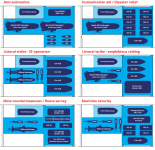My opinion with this is that you are effectively bring the same issue up as we dealt with when the RCN decided to leave behind a split GP and AAW specification for the CSC, instead leaning into a single homogenous specification set. If you convert a handful of CSC's to remove the mission bay and replace it with VLS, you are going to be dealing with the same availability issues that most navies with small fleets of specialist AAW vessels have. You'd need to convert 2-3 (or more) ship to make sure you'll always have 1 AAW variant available, then you have two separate coasts to add into the equitation. Seems like you'd end up cutting a fair few of the CSC's mission bay capability out and I don't think that is especially wise.
The multi-mission bay is a hedge to allow the ships to take on the future developments and implementation of unmanned systems alongside bringing some much needed variety to the roles the class can undertake. Without the mission bay, the CSC only has a single boat bay on the port side. Taking out or cutting down the bay will have some major knock on effects for what the CSC can do now that it lacks any kind of small boat capability, drug interdiction and piracy control are two I'd point out. It would also pretty heavily remove any ability to do more covert operations like supporting CANSOFCOM operations with a platform that isn't an AOPS or a JSS. Being able to support mine warfare using unmanned systems is something that shouldn't be an explicit role but it is definitely something that could be useful, look at the 280's back during the Gulf War. Being able to do humanitarian work at home or abroad with that cargo capability and the ability to offload its own cargo is something else that is very useful, we've sent 280's and Halifax's to do these sorts of roles in the past and CSC will be able do exceed their limited capabilities by leaps and bounds.
The primary purpose I see for the mission bay is its ability to incorporate unmanned systems to supplement the ASW capability of the CSC significantly. Having this ability could be absolutely key going forward as these unmanned systems further develop. Other nations without this kind of mission bay could be stuck holding the bag with their legacy designs. This class will be the backbone of the RCN going forward, I expect to see them used sometimes in roles where they might be overkill but we've done that plenty with our current frigates. I would be cautious to not overly analyze current trends and developments, we are very much in the part of the arms race where the "disruptive technology" has the head start and developments from the other side have been somewhat slow. There are systems and ways for CSC to potentially harden itself against unmanned systems without something as drastic as the removal of the mission bay.
The image below showcases roles and equipment that the RN thinks will be useful for employment of their own mission bay equipped Type 26's, I don't think we should ignore of wave off the utility of such a system at this point. Weapons are something attractive to the point people can miss the more important but less glamorous capabilities a ship has.
View attachment 83207




